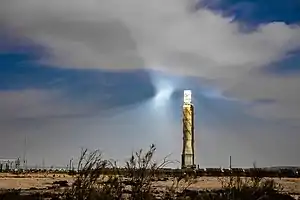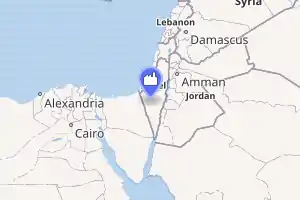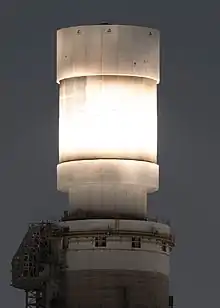Ashalim Power Station
The Ashalim power station is a solar power station in the Negev desert near the kibbutz of Ashalim, south of the district city of Be'er Sheva) in Israel. It is a joint venture between Brightsource and Alstom. The station was the tallest solar power tower in the world at a height of 260 meters including the boiler[1] but was recently surpassed by the 262 meter tall solar power tower at the Mohammed bin Rashid Al Maktoum Solar Park.[2]
| Ashalim power station | |
|---|---|
 | |

| |
| Official name | Ashalim Solar Thermal Power Station |
| Country | Israel |
| Location | Negev Desert |
| Coordinates | 30.96502°N 34.72602°E |
| Status | Operational |
| Construction began | 2014 |
| Commission date | 2018 |
| Construction cost | US$570 million |
| Owner(s) | Megalim Solar Power |
| Operator(s) | Alstom |
| Solar farm | |
| Type | CSP |
| CSP technology | Solar power tower |
| Site area | 3.15 km2 (1.22 sq mi) |
| Power generation | |
| Nameplate capacity | 121 MW |
| External links | |
| Website | http://www.brightsourceenergy.com/ashalim-solar-project |
| Commons | Related media on Commons |
The station has an installed capacity of 121 megawatts,[3] concentrating 50,600 computer-controlled heliostats enough to power 120,000 homes. Electricity production commenced in September 2019,[4] producing 320 GWhr of energy per year .[5] The solar tower uses molten salt to allow the plant to operate for up to 4.5 hours after sunset.[4]
When further phases of the project are complete, the station will combine 3 kinds of energy: solar thermal energy, photovoltaic energy, and natural gas. A 30MW PV plant is planned, and a second CSP plant will also be built.[6][7]
Reasons for building the power station

According to a press release of the National Infrastructure Minister of Israel, the establishment has several motivations:
- Economic motivation: reducing imports thus balancing the trade and releasing foreign currency.
- Political motivation: reducing strategic dependence on foreign energy sources.
- Environmental motivation: reducing contamination levels.
- Scientific motivation: pushing forward local technology and science, adapting new technologies from abroad.
References
- Scharf, Isaac (January 5, 2017). "Israel harnessing sunshine with world's tallest solar tower". The Times of Israel. Retrieved August 29, 2017.
- https://constructionreviewonline.com/2020/06/worlds-tallest-concentrated-solar-power-tower-installed/
- Bright Source Energy - Ashalim
- "Ashalim Solar Thermal Power Station inaugurated in Israel". Retrieved 2019-12-31.
- Ashalim Power Station, Israel
- BrightSource and Alstom win tender for 121 Megawatt solar thermal power plant in Israel
- "Emissions free and pollution free: Israel unveils massive solar power plant". Ynetnews. 2019-10-19. Retrieved 2019-11-19.
External links
- Weizmann Institute of Science - Center for Energy Research
- CSP plants and projects plotted on Google Earth
- Megalim Solar Power LTD is a B.O.T. concession company owned by Noy Fund (49.9%), BrightSource (25.05%), and GE Renewable Energy (25.05%) . The company has won the tender by the State of Israel for the construction, planning, financing and operation of a solar-thermal power plant in Ashalim (Plot B) with a rating of 121 MW and expected to supply 320 GWh of electricity annually into Israel’s grid.